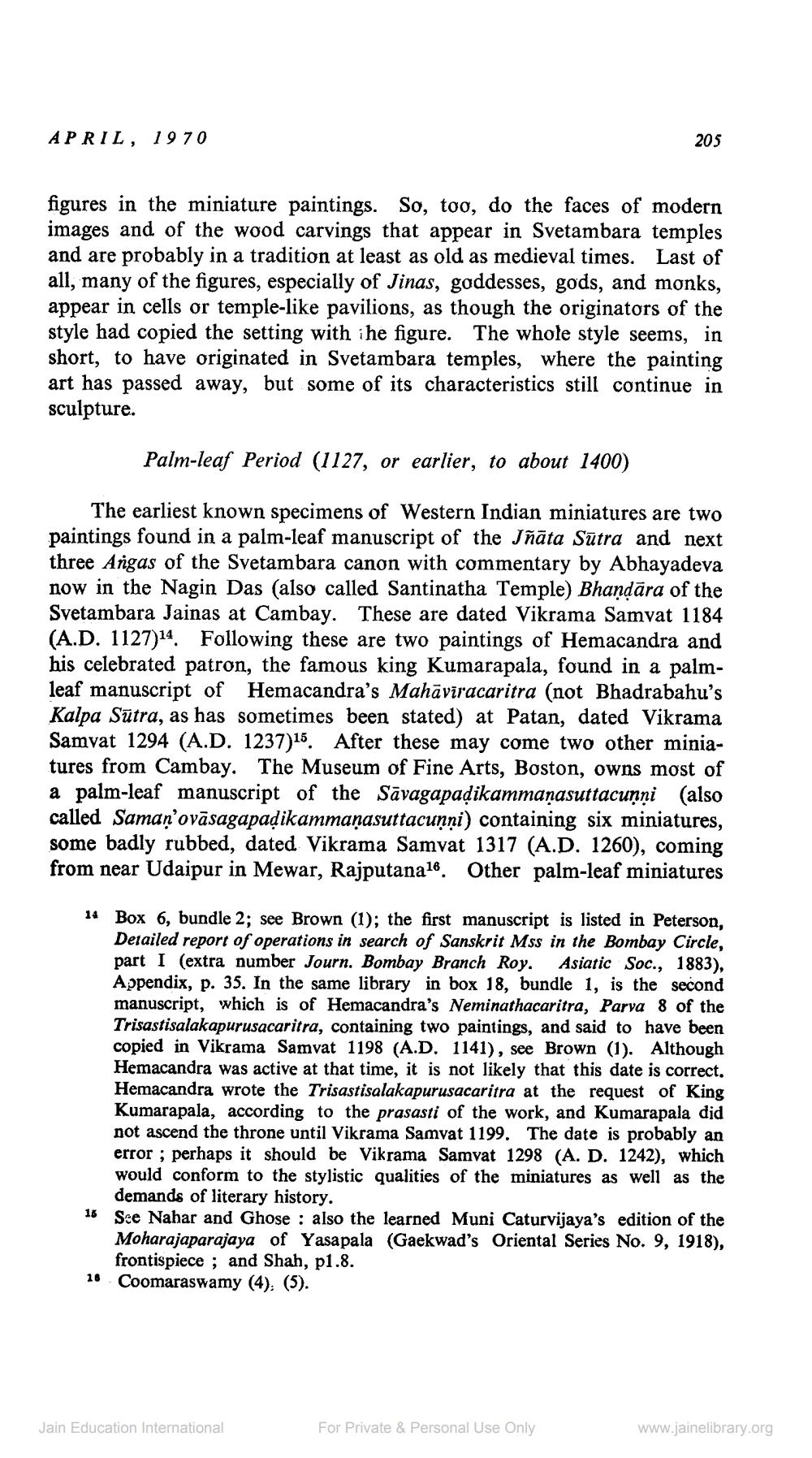________________
APRIL, 1970
figures in the miniature paintings. So, too, do the faces of modern images and of the wood carvings that appear in Svetambara temples and are probably in a tradition at least as old as medieval times. Last of all, many of the figures, especially of Jinas, goddesses, gods, and monks, appear in cells or temple-like pavilions, as though the originators of the style had copied the setting with the figure. The whole style seems, in short, to have originated in Svetambara temples, where the painting art has passed away, but some of its characteristics still continue in sculpture.
Palm-leaf Period (1127, or earlier, to about 1400)
The earliest known specimens of Western Indian miniatures are two paintings found in a palm-leaf manuscript of the Jñāta Sutra and next three Angas of the Svetambara canon with commentary by Abhayadeva now in the Nagin Das (also called Santinatha Temple) Bhandara of the Svetambara Jainas at Cambay. These are dated Vikrama Samvat 1184 (A.D. 1127)14. Following these are two paintings of Hemacandra and his celebrated patron, the famous king Kumarapala, found in a palmleaf manuscript of Hemacandra's Mahaviracaritra (not Bhadrabahu's Kalpa Sutra, as has sometimes been stated) at Patan, dated Vikrama Samvat 1294 (A.D. 1237)15. After these may come two other miniatures from Cambay. The Museum of Fine Arts, Boston, owns most of a palm-leaf manuscript of the Savagapaḍikammanasuttacunni (also called Samaṇ'ovāsagapaḍikammaṇasuttacuṇni) containing six miniatures, some badly rubbed, dated Vikrama Samvat 1317 (A.D. 1260), coming from near Udaipur in Mewar, Rajputana16. Other palm-leaf miniatures
205
14 Box 6, bundle 2; see Brown (1); the first manuscript is listed in Peterson, Detailed report of operations in search of Sanskrit Mss in the Bombay Circle, part I (extra number Journ. Bombay Branch Roy. Asiatic Soc., 1883), Appendix, p. 35. In the same library in box 18, bundle 1, is the second manuscript, which is of Hemacandra's Neminathacaritra, Parva 8 of the Trisastisalakapurusacaritra, containing two paintings, and said to have been copied in Vikrama Samvat 1198 (A.D. 1141), see Brown (1). Although Hemacandra was active at that time, it is not likely that this date is correct. Hemacandra wrote the Trisastisalakapurusacaritra at the request of King Kumarapala, according to the prasasti of the work, and Kumarapala did not ascend the throne until Vikrama Samvat 1199. The date is probably an error; perhaps it should be Vikrama Samvat 1298 (A. D. 1242), which would conform to the stylistic qualities of the miniatures as well as the demands of literary history.
15 See Nahar and Ghose: also the learned Muni Caturvijaya's edition of the Moharajaparajaya of Yasapala (Gaekwad's Oriental Series No. 9, 1918), frontispiece; and Shah, p1.8.
Coomaraswamy (4); (5).
16
Jain Education International
For Private & Personal Use Only
www.jainelibrary.org




